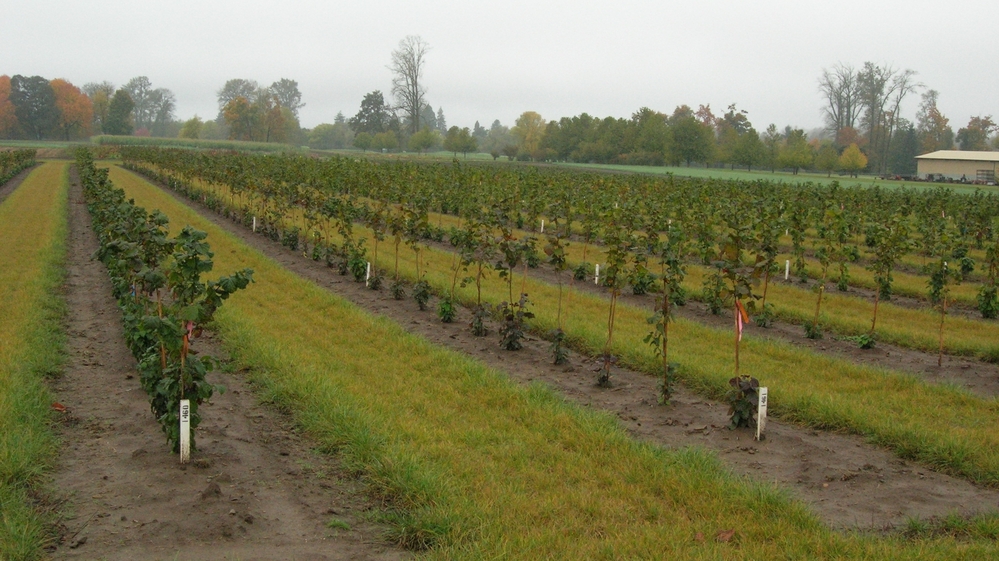 Enlarge image i
Enlarge image i Oregon State University has been growing a variety of hazelnut trees over the years to develop blight-resistant breeds.

Oregon State University has been growing a variety of hazelnut trees over the years to develop blight-resistant breeds.
Although Oregon is known for many exports from timber to hipster irony few people are aware that it's actually the country's leading source of hazelnuts.
Growers estimate that 99 percent of the United States' crop comes from Oregon's Willamette Valley. Just a few years ago, the industry was on the verge of collapse due to a disease called Eastern filbert blight. Now, years of research have brought blight-resistant breeds to fruition.
The disease first hit the region in the late 1980s. Infected trees develop cankers, which gradually kill off the branches.
"It's just like cancer for trees, there's no real answer to it yet," says Tanner Koenig, a young farmer who grew up fighting blight. "It's just some of them have a 20-year lifespan left, some of them, it's five. Some orchards, we're taking trees out already."
 Enlarge image i
Enlarge image i Trees infected with Eastern filbert blight develop cankers that will kill of its branches.

Trees infected with Eastern filbert blight develop cankers that will kill of its branches.
Farmers initially struggled with handling the disease. They tried to cut off trees at the base (that actually led to new growth, which was more susceptible to the disease). They also sprayed the trees in the fall with copper-based fungicides only to later find that the sprays were only effective on new bud growth, which happens in the spring.
The growers' association taxed its members and put the funds into research, which developed a regimen that extended the life of infected trees. But it came at a high cost in terms of manpower, as Koenig explains.
"It's a constant battle. I have four guys who prune every day from the first of November until the end of March," he says. "It takes two guys to stack up all the branches all winter long, and then they spray about four times for it in the springtime."
While farmers struggled to keep trees alive, researchers struggled to find a solution that would save the industry: a blight-resistant hazelnut. Shawn Mehlenbacher, professor of horticulture at Oregon State University, has been working on developing the resistant hazelnuts for more than 25 years.
Creating special breeds is a long process. It takes eight years to grow a hazelnut generation, and each new variety must go through several generational crosses before it's ready for testing.
Even determining whether the strain is resistant takes time. After Mehlenbacher infects a tree with blight, he has to wait 16 months to see if it gets the disease.
Mehlenbacher didn't start his work from scratch. The first cross-pollination to develop trees with blight resistance happened in the late 1970s. Scientists happened upon a blight-resistant pollinator in the fields with a gene they named gasaway and began the slow process of breeding trees that shared that resistance, as well as producing prolific, tasty nuts. By the time farmers were really hurting, OSU could offer plants that were not perfect, but had at least some resistance, taking longer to become stricken with blight.
"The first release by the OSU breeding program that really had an impact on the industry was [the Lewis breed], in 1997," Mehlenbacher says. "It was planted quite widely kept the industry alive for another decade."
These semi-resistant varieties served as bridge for farmers, helping them hang on until fully resistant trees were introduced.
Now, those trees pioneer breeds like Jefferson, Yamhill, Santiam and others are all over the Willamette Valley. Admittedly, in tree years, these varieties haven't been around very long. But farmers are putting their hope in them, replacing blighted trees with these new varieties.
Most farmers continue to spray and prune the old trees, trying to keep them going as long as possible.
But some, like Rich Birkemeier, are just cutting the expense. This winter he's pulling up about 1,500 of the semi-resistant Lewis trees that have finally gone under and planting the new, fully resistant trees in their place.
Birkemeier expects to see these new, blight-resistant trees still bearing nuts by the time his grandchildren are working the farm.
contorted filbert trees for sale - Growing Hazelnuts - At ... contorted filbert trees FOR SALE! One of the newest ornamental releases out of Oregon State University's hazelnut breeding program, this ... HORTICULTURE GROWERS SHORT COURSE HORTICULTURE GROWERS SHORT COURSE at TRADEX Abbotsford Airport (Exit 83 South of Hwy1) together with the Paciic Agriculture Show Lower Mainland Horticulture ... Tree Diseases - How To Information eHow.com Don't just sit there scratching your head, find useful info on Tree Diseases on eHow. Get essential tips and learn more about everything from Olea Europaea Tree ... Our Nursery - Growing Hazelnuts - At Birkemeier Farms, Inc At Birkemeier Farms, we take quality seriously. We grow strong, vigorous filbert nursery stock and hand-sort our product, ensuring that we sell the best. Composition Patterns: Comparison and Contrast Perhaps the most common assignment in a Composition course is the comparison and contrast essay. What could be easier? We've got these two things movies, books ... Oregon Tree Fruits and Nuts - Purdue University Oregon CropMAP Oregon Tree Fruits and Nuts. Prepared by Kim E. Hummer, Research Leader and Curator, USDA ARS National Clonal Germplasm Repository, 33447 Peoria Road ... National Clonal Germplasm Repository (Corvallis, Oregon) : NCGR ... Corylus L., the hazelnut, is one of the major world nut crops. World production of hazelnuts, which was 745,078 metric tons in 1998, is second only to almond. Turkey ... Sandusky Valley Nursery is an Ohio based online and mail order ... European Hazelnut-Filbert Tree. Hazelnut tree/Filbert (Corylus avellana) tree is a small tree from europe that produces nice sized hazel nuts ...
No comments:
Post a Comment